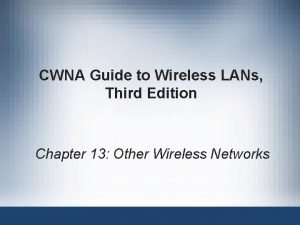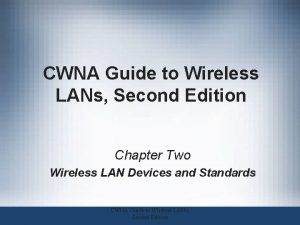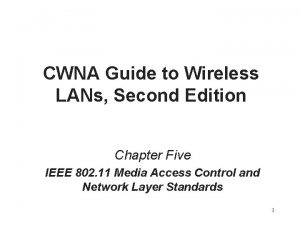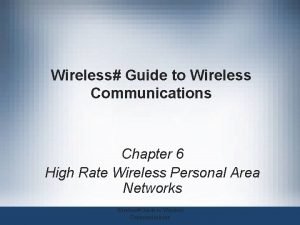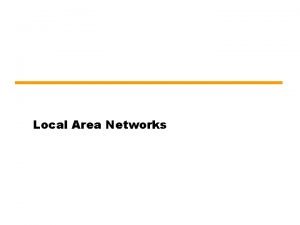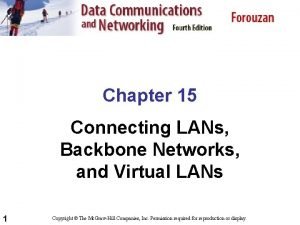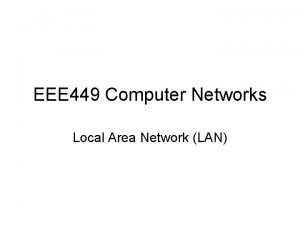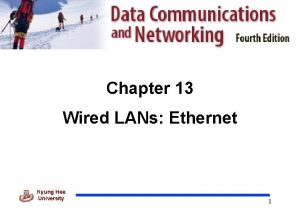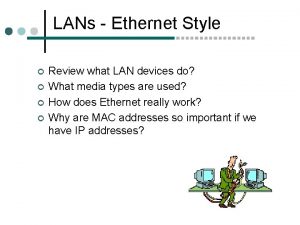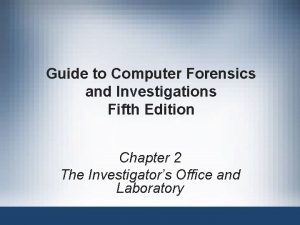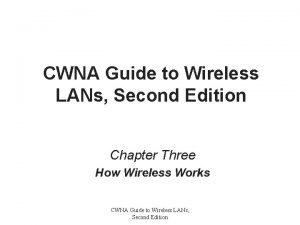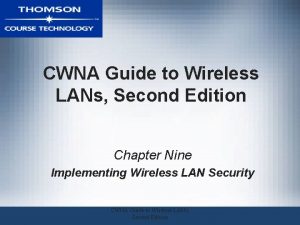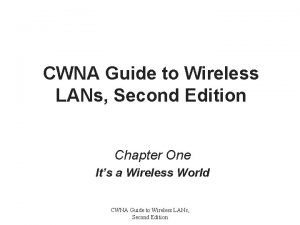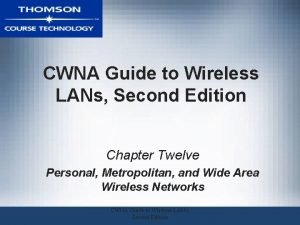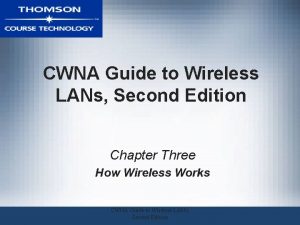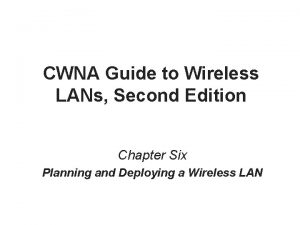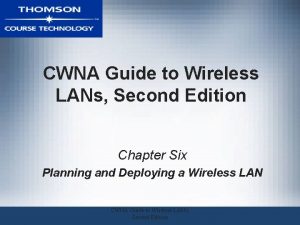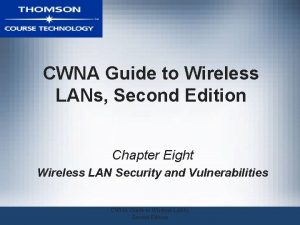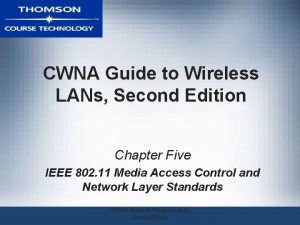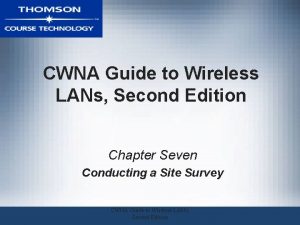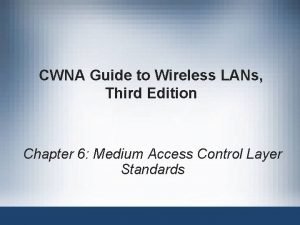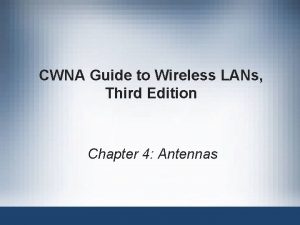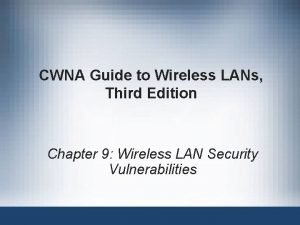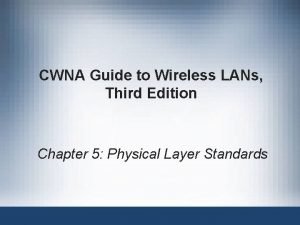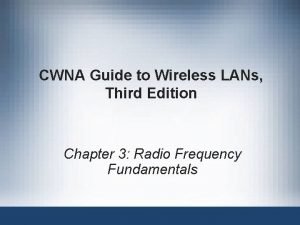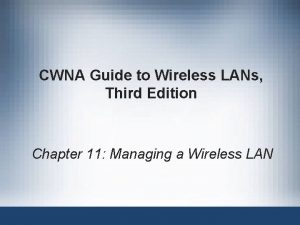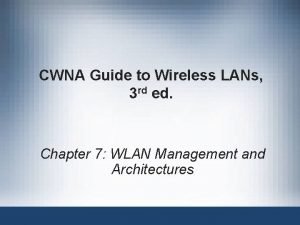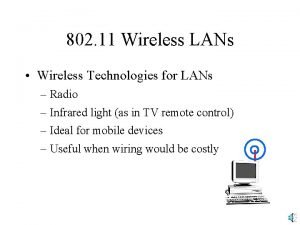CWNA Guide to Wireless LANs Second Edition Chapter







































- Slides: 39

CWNA Guide to Wireless LANs, Second Edition Chapter Seven Conducting a Site Survey 1

Objectives • Explain what a site survey is • Describe the tools that are used in a site survey • Describe how to perform a site survey 2

What is a Site Survey? • When installing a WLAN for an organization, areas of dead space might not be tolerated – Ensure blanket coverage, meet per-user bandwidth requirements, minimize “bleeding” of signal • Factors affecting wireless coverage goals: – – – Devices emitting RF signals Building structure (walls, construction materials) Open or closed office doors Stationary versus mobile machinery/equipment Movement of mobile walls (e. g. , cubicles) 3

What is a Site Survey? (continued) • Factors affecting wireless coverage goals (continued): – Expansion of physical plant or growth of organization – Existing WLANs • Both inside organization, and within nearby organizations • Site survey: Process of planning a WLAN to meet design goals – Effectiveness of a WLAN often linked to thoroughness of the site survey 4

What is a Site Survey? (continued) • Design goals for a site survey: – – Achieve best possible performance from WLAN Certify that installation will operate as promised Determine best location for APs Develop networks optimized for variety of applications – Ensure coverage will fulfill organization’s requirements – Locate unauthorized APs 5

What is a Site Survey? (continued) • Design goals for a site survey (continued): – Map nearby wireless networks to determine existing radio interference – Reduce radio interference as much as possible – Make wireless network secure • Survey provides realistic understanding of infrastructure required for proposed wireless link – Assists in predicting network capability and throughput – Helps determine exact location of APs and power levels required 6

What is a Site Survey? (continued) • When to perform a site survey: – – – Before installing a new wireless network Before changing an existing wireless network When there are significant changes in personnel When there are changes in network needs After making physical changes to a building 7

Site Survey Tools: Wireless Tools • Most basic tool is AP itself: – Position AP in various locations, monitor signal as you move – APs should have ability to adjust output power – APs should have external antenna connectors • Test effectiveness of different antenna types in different situations – May need DC-to-AC converter for testing • Notebook computer with wireless NIC also essential for testing – Previously configured and tested 8

Site Survey Tools: Wireless Tools (continued) Adjusting AP power levels 9

Site Survey Tools: Wireless Tools (continued) External antenna connectors 10

Site Survey Tools: Measurement Tools • Site Survey Analyzers: Specifically designed for conducting WLAN site surveys – Software often built into AP – Receive Signal Strength Indicator (RSSI) value – Full-featured site survey analyzer software settings: • • • Destination MAC Address Continuous Link Test Number of Packets Packet Size Data Retries 11

Site Survey Tools: Measurement Tools (continued) • Site Survey Analyzers (continued): – Full-featured site survey analyzer software settings (continued): • Data Rate • Delay Between Packets • Packet Tx Type – Unicast or multicast • Percent Success Threshold – Basic survey analyzer software contains far fewer features 12

Site Survey Tools: Measurement Tools (continued) Full-featured site survey analyzer software setup 13

Site Survey Tools: Measurement Tools (continued) Full-featured site survey analyzer software results 14

Site Survey Tools: Measurement Tools (continued) Basic site survey analyzer software results 15

Site Survey Tools: Measurement Tools (continued) • Spectrum Analyzers: Scan radio frequency spectrum and provides graphical display of results – Typically measure signal-to-noise ratio – Single-frequency analyzers measure signal-to-noise ratio at specified frequency – Helpful in identifying interference problems • Thus, helps properly position/orient AP 16

Site Survey Tools: Measurement Tools (continued) Single-frequency analyzer 17

Site Survey Tools: Measurement Tools (continued) Spectrum analyzer 18

Site Survey Tools: Measurement Tools (continued) • Network Analyzers: Can be used to pick up packets being transmitted by other WLANs in area – Provide additional information on transmissions – Packet sniffers or protocol analyzers – Not used in placement of AP 19

Site Survey Tools: Documentation Tools • Create a “hard copy” of site survey results – Make available for future reference – No industry-standard form for site survey documentation • Site survey report should include: – – – Purpose of report Survey methods RF coverage details (frequency and channel plan) Throughput findings Sources of interference 20

Site Survey Tools: Documentation Tools (continued) • Site survey report should include (continued): – Problem zones – Marked-up facility drawings with access point placement – Access point configuration • Use plain paper and building layout blueprints as tools • Advisable to create database to store site survey information and generate reports 21

Site Survey Tools: Documentation Tools (continued) Sample site survey form 22

Performing a Site Survey: Gathering Data • Obtaining Business Requirements: Determine business reasons why WLAN being proposed or extended – If this step skipped, almost impossible to properly design and implement the network – Primary data gathering method is interviewing – Must determine type of mobility required within organization – Must determine per-user bandwidth requirements • May be different “types” of users with different bandwidth requirements 23

Performing a Site Survey: Gathering Data (continued) • Defining Security Requirements: Consider type of data encryption and type of authentication that will take place across WLAN – Consider existing security policies and procedures • Gathering Site-Specific Documentation: – Blueprints, facility drawings, and other documents • Show specific building infrastructure components – Inspecting the site • Document changes to blueprints and get visual perspective 24

Performing a Site Survey: Gathering Data (continued) • Gathering Site-Specific Documentation (continued): – Behind-the-scenes site inspection • May require ladder, flashlight, and an escort • Documenting Existing Network Characteristics: New or expanded WLAN will “dovetail” into network already in place – Determine degree to which WLAN will interact with other wired networks – Legacy systems may require additional equipment to support WLAN 25

Performing a Site Survey: Performing the Survey • Collecting RF Information: – Note objects in and layout of room • Use digital camera – Position AP • Initial location will depend on antenna type • Document starting position of AP – Using notebook computer with site survey analyzer software running, walk slowly away from AP • Observe data displayed by analyzer program – Data rate, signal strength, noise floor, and signal-to -noise ratio 26

Performing a Site Survey: Performing the Survey (continued) Position of APs 27

Performing a Site Survey: Performing the Survey (continued) • Collecting RF Information (continued): – Continue moving until data collected for all areas – Data collected used to produce: • Coverage pattern: Area where signal can be received from the AP • Data rate boundaries: Range of coverage for a specific transmission speed • Throughput: Number of packets sent and received and data rates for each • Total transmission range: Farthest distance at which signal can be received by wireless device 28

Performing a Site Survey: Performing the Survey (continued) Coverage pattern 29

Performing a Site Survey: Performing the Survey (continued) Data rate boundaries 30

Performing a Site Survey: Performing the Survey (continued) • Collecting Non-RF Information: – Sources of interference can include: • Wire mesh security windows, Aquariums, Outer walls, Ceramic or marble floors, Concrete floors or pillars, Security booth bullet-proof glass, Mirrors, and Elevator shafts or filing cabinets – Electrical and network connections • Outdoor Surveys: Similar to indoor surveys, but must consider climatic conditions, trees, different possibilities for antenna positions 31

Performing a Site Survey: Performing the Survey (continued) • Outdoor Surveys (continued): – Different tools may be required • • GPS Range finder Tape measure Lighting beacons, flares, and spotlights • Finalizing the Survey Documents: Final result is map of optimal areas of coverage for placement of access point – If results unacceptable, must relocate AP and start over 32

Performing a Site Survey: Creating the Site Survey Report • Narrative section: – State customer requirements – Outline methodology • Outline all steps taken during survey – Clearly state results of measurements • May have tables of measurements – Recommendations • Should always address security 33

Performing a Site Survey: Creating the Site Survey Report (continued) Table of measurements 34

Performing a Site Survey: Creating the Site Survey Report (continued) • Graphic section: – Generally includes maps and diagrams of coverage area • Data rate coverage map • Signal-to-noise ratio plot 35

Performing a Site Survey: Creating the Site Survey Report (continued) Data rate coverage map 36

Performing a Site Survey: Creating the Site Survey Report (continued) 3 -D signal-to-noise ratio plot 37

Summary • A site survey is an in-depth examination and analysis of a proposed wireless LAN site to meet design goals • Three categories of tools used – Wireless tools include the access point and notebook computers with a wireless NIC – Measurement tools include site survey analyzers, spectrum analyzers, and network analyzers – Documentation tools create a “hard copy” of the site survey results for future reference 38

Summary (continued) • Three steps in conducting a site survey – Gather the background data – Perform the actual survey – Create the site survey report, containing a narrative and a graphical section 39
 Cwna guide to wireless lans 3rd edition
Cwna guide to wireless lans 3rd edition Cwna guide to wireless lans
Cwna guide to wireless lans Cwna guide to wireless lans
Cwna guide to wireless lans Guide to wireless communications 4th edition
Guide to wireless communications 4th edition Telecommunications the internet and wireless technology
Telecommunications the internet and wireless technology High speed lans
High speed lans Connecting remote lans
Connecting remote lans Lans
Lans Wired lans ethernet
Wired lans ethernet Lans style
Lans style Internet technologies and applications
Internet technologies and applications Show that the maximum efficiency of pure aloha is 1/(2e).
Show that the maximum efficiency of pure aloha is 1/(2e). Adam lans
Adam lans Wired lans
Wired lans Guide to wireless communications
Guide to wireless communications 186 282 miles per second into meters per second
186 282 miles per second into meters per second Advanced word power second edition answers
Advanced word power second edition answers Accounting principles second canadian edition
Accounting principles second canadian edition Accounting principles second canadian edition
Accounting principles second canadian edition Accounting principles second canadian edition
Accounting principles second canadian edition Clear thinking and writing
Clear thinking and writing Accounting principles second canadian edition
Accounting principles second canadian edition Kaufman test of educational achievement second edition
Kaufman test of educational achievement second edition Introduction to algorithms second edition
Introduction to algorithms second edition In company second edition
In company second edition Wechsler individual achievement test second edition
Wechsler individual achievement test second edition Ten steps to advanced reading second edition answers
Ten steps to advanced reading second edition answers Klein
Klein Mis chapter 6
Mis chapter 6 Using mis 10th edition
Using mis 10th edition Florida real estate broker's guide 6th edition
Florida real estate broker's guide 6th edition Florida real estate broker's guide
Florida real estate broker's guide A pocket guide to public speaking 6th edition free
A pocket guide to public speaking 6th edition free Guide to computer forensics and investigations 6th edition
Guide to computer forensics and investigations 6th edition Prehospital emergency care 11th edition study guide
Prehospital emergency care 11th edition study guide Florida real estate broker's guide 6th edition
Florida real estate broker's guide 6th edition Florida real estate broker's guide 6th edition
Florida real estate broker's guide 6th edition Building a forensic workstation
Building a forensic workstation Florida real estate broker's guide 6th edition
Florida real estate broker's guide 6th edition A pocket guide to public speaking 6th edition
A pocket guide to public speaking 6th edition
